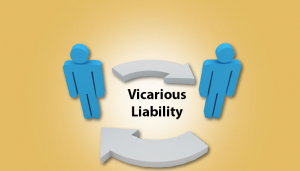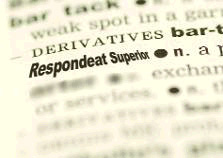This article has been written by Shubham Khunteta, a student of National Law University, Odisha, about one of the most often used doctrine in contract and tort: “Doctrine of Respondeat Superior.” It talks about the relevance of the doctrine in deciding the case in hand by the courts. It provides for an interpretation of the doctrine.
Principle to Resolve the Relationship Between Master-Servant and Employer-Employee for Liability Incurred
Introduction
There are various doctrines governing the relationship between master-servant and employer-employee. These doctrines are often employed to determine the liability of a person. Among such doctrines is the doctrine of Respondeat Superior based on the concept of vicarious liability. This doctrine is in vogue based on various factors like-
- The economic capacity of the subordinates, i.e., employees or agents who are presumed to be working under someone’s direction and authority due to their monetary needs. Some of the agents or employees may be getting meagre wages or salaries for the services they are providing. Infallibility in one’s work is not expected from anyone, even the employer.
Due to such fallibility and negligence, such employees or agents may be subjected to the extreme stress if they are directed to compensate the third-party for the negligence in their work. Also, they may not be able to compensate as directed, due to their presumed subordinate position, which would not only impact them but also the person who is injured by their negligent act as they would not be able to get satisfactory compensation. So, to prevent such a situation from occurring, the superior person like the master or employer is asked to accept the liability of their servant or employee respectively and compensate the affected party. But such blanket acceptance of the liability of the superiors might threaten their interests. Thus, this principle was formulated to regulate such incidents and arrive at proper and equitable justice.
- The principle also evolved because working for someone in the course of employment without attributing liability on them for the acts of subordinates would allow them to shed and bend their responsibility in choosing responsible and qualitative subordinates. Proper verification and screening would be unimaginably affected. Blame games would surface and increase in such incidences would be reported. The liability on the employer and the master would compel them to choose with prudence, due care, and caution the subordinates.
- This will also control the employers’ and masters high-handedness and prompt them to be careful and responsive to the needs of their subordinates.
Concept of Doctrine of Respondeat Superior
The doctrine had its origin in the United States and originated from a Latin word meaning,“Let the master answer.” This doctrine was brought on the premise of the limited economic capacity of the subordinates and to control the irresponsible behavior of superiors like the masters or employers. This doctrine is founded on public policy as its purpose is to allocate to the business the risks normally attendant thereto[1]. When this doctrine applies, an employer and the master will be liable for an employee’s and the servant’s negligent commissions or omissions that occur during employment. However, there should be the establishment of a relationship between the superior and the subordinate for the liability to fall on the superiors.
 Acts which are done by the subordinates by their employment and agency can be with the express or implied authority of an employer and a master respectively.
Acts which are done by the subordinates by their employment and agency can be with the express or implied authority of an employer and a master respectively.
There are two requirements of the doctrine:
- A true master-servant and employer-employee relationship must be there so that a master and an employer may be properly charged with the servant’s and the employee’s act as his own.
- The tortious act of a servant and an employee must be one within the scope of his employment
Here, ‘scope of employment’ implies that the act is done with the express or implied authority of the superiors.
The Court in a case refused to accept the submission of a Contract of Service, i.e., a contract for temporary requisition of services. The Court opined that as the controlling authority, the hospital is responsible as it owes a duty to the patients and thereby can’t be exonerated for lack of care. The hospital, as a principal was held liable under the doctrine of Respondeat Superior.
Tests for Determination of Relationship
The Direction and Control Test[2] [***Used formerly as now it has become redundant]
It suggests that to differentiate the relationship of master-servant from that of independent contractors, the direction, and control which the masters exercise to make them liable for the act of their servants. It implies that the authority of the master to direct and command the agent to do authorized work and control his actions during the course of employment is the defining characteristic to presume liability of the master.
This is not case with an independent contractor, who is the person employed for the services, as although directions can be given but there is no control, for example, while hiring a taxi one can give directions to taxi driver, but one can’t control his actions as to how to go the way and drive, and Independent Director uses his discretion in things not specified beforehand. For further details on the distinction b/w Independent contractor and an employee see the case[3].
The Hire and Fire Test (Used now)
In the recent years, with the development of science and technology, the ‘control’ test to determine the relationship of ‘master and servant’ has fallen into disrepute and the old test of ‘control’ cannot be strictly applied in each case. Right of control remains an important factor in those cases where it can be applied, but it is not the only matter to be taken into account to determine the existence of the relationship of master and servant. The test of ‘hire’ and ‘fire’ has of late has assumed more importance[4].
It suggests that an employee and a servant can be fired if they do any act which is not permitted. So not only control but what also separates the relationship of master-servant from that of an independent contractor is that the servant can be can be fired from work if he does something which he is not permitted to do.
Course of Employment
The course of employment according to Black’s law dictionary is a legal consideration of all circumstances which may occur in the performance of a person’s job, especially during a period of time where specific objectives are given by the employer to the employee.
 In a case[5], the Court laid down the following propositions in connection with the construction of the expression ‘in the course of employment’. They are: (i) as a rule, the employment of a workman does not commence until he has reached the place of employment and does not continue when he has left the place of employment; (ii) as a rule the journey to and from the place of employment is not included within the expression ‘in the course of employment (iii) the aforesaid two positions are subject to the theory of notional extension of the employers’ premises so as to include the area which the workman passes and re-passes in going to and in leaving the actual place of work; there may be some reasonable extension in both time and place and a workman may be regarded as in the course of his employment even though he had not reached or had left his employers’ premises; (iv) the facts and circumstances of each case will have to be examined very carefully in order to determine whether the accident arose within and in the course of employment keeping in view at all times, the theory of notional extension. On the basis of the first two propositions, the deceased cannot be said to have received the injuries in an accident arising out of and in the course of his employment.
In a case[5], the Court laid down the following propositions in connection with the construction of the expression ‘in the course of employment’. They are: (i) as a rule, the employment of a workman does not commence until he has reached the place of employment and does not continue when he has left the place of employment; (ii) as a rule the journey to and from the place of employment is not included within the expression ‘in the course of employment (iii) the aforesaid two positions are subject to the theory of notional extension of the employers’ premises so as to include the area which the workman passes and re-passes in going to and in leaving the actual place of work; there may be some reasonable extension in both time and place and a workman may be regarded as in the course of his employment even though he had not reached or had left his employers’ premises; (iv) the facts and circumstances of each case will have to be examined very carefully in order to determine whether the accident arose within and in the course of employment keeping in view at all times, the theory of notional extension. On the basis of the first two propositions, the deceased cannot be said to have received the injuries in an accident arising out of and in the course of his employment.
In another case[6], the Court held “To come within the Act, the injury by accident must arise both out of and in the course of employment. The words in the course of the employment mean in the course of the work which the workman is employed to do and which is incidental to it. The words arising out of employment are understood to mean that during the course of the employment, injury has resulted from some risk incidental to the duties of the service, which, unless engaged in the duty owing to the master, it is reasonable to believe the workman would not otherwise have suffered. In other words, there must be a causal relationship between the accident and the employment. The expression arising out of employment is again not confined to the mere nature of the employment. The expression applies to employment as such to its nature, its conditions, its obligations and its incidents. If because of any of those factors, the workman is brought within the zone of special danger, the injury would be one which arises out of employment. To put it differently, if the accident had occurred on account of a risk which is an incident of the employment, the claim for compensation must succeed unless of course, the workman has exposed himself to an added peril by his imprudent act.”
Case Laws on Doctrine of Respondeat Superior
In the case of Automobiles Transport vs. Dewalal and ors, the Rajasthan High Court held that the Automobiles transport company is liable for the acts of the servant done by him/her in the course of employment. The presumption that the vehicle is driven on the master’s instruction or by his authorised agent or servant is always there, and it is on the appellant to prove that such presumption is unwarranted and not verified. The argument of the appellant that the driver was not directed to go through a particular way did not evince interest on their lordship because it is farcical at its best as one can’t expect. For example, the driver was to wait in case of blockade of a particular direction and not move in the other direction to carry out its work although, in case the road is clear, there may be a different picture altogether. Failure to prove such a requirement would condemn the appellant for liability under the both the principle of vicarious liability and doctrine of Respondeat Superior.
In the case of Smt. Savita Garg vs. The Director, National Heart Institute[7], the Supreme Court held that in the contract of employment, the hospital is the principal who is responsible for the act of the agent, i.e., one of its doctors if it is unable to justify the court and the complainant that there was no negligence or recklessness on their part and that they acted with due care and caution. As the hospital is in a better position to render such information when demanded as to what medicine was administered, failure to disclose such information would render them culpable. In cases of medical negligence, ordinary human fallibility may prevent the liability if it is a case of a bonafide mistake. However, a mistake of negligence can’t be absolved[8].
Conclusion
The doctrines are an important part of any law, and they help to resolve the case in a non-discriminatory manner to the maximum possible extent. The doctrine of Respondeat Superior has also developed to manage such problems in a manner so as to not lose the element of equity while considering the economic capacity of the affected parties. This doctrine evolved to administer and settle the disputes of the relationship between the master-servant and employer-employee and spruce up avenues to prevent dragging of cases on the conflict of less compensation at the hands of the subordinates. This doctrine ensured that the superior position of the employer and masters are used to leverage the victim affected due to negligence either of the master and employers themselves or servants or employees.
It can thus be deduced that this doctrine is based on the principle of vicarious liability and is used when one acts, under the direction and control of others and commits some negligent act injuring another, liability can be imposed on the person of a superior position and cases can be settled, bearing in mind, this doctrine.
[divider]Footnotes:
[1]Mechem, Outline of the law of agency, p. 359.
[2] <http://lex-warrier.in/2011/02/justification-of-vicarious-liability/>accessed on 14/06/2016
[3] Performing Right Society Ltd. vs. Mitchell and Booker (Palais De Danse) Ltd [1924] 1 KB 762
[4] the Union of India vs. Abdul Rehman and Ors. AIR 1981 J K 60
[5] S. S. Manufacturing Co. v. Bai Valu Raja AIR 1958 SC 881
[6] Mackinnon. Mackenzie & Co. (P). Ltd. v. Ibrahim Mahammad. Issak, AIR 1970 SC 1906
[7] (2004) 8 SCC 56
[8] Spring Meadows Hospital & Anr. v. Harjol Ahluwalia (1998) 4 SCC 39
Students of Lawsikho courses regularly produce writing assignments and work on practical exercises as a part of their coursework and develop themselves in real-life practical skills.
LawSikho has created a telegram group for exchanging legal knowledge, referrals, and various opportunities. You can click on this link and join:
Follow us on Instagram and subscribe to our YouTube channel for more amazing legal content.
 Serato DJ Crack 2025Serato DJ PRO Crack
Serato DJ Crack 2025Serato DJ PRO Crack









 Allow notifications
Allow notifications



